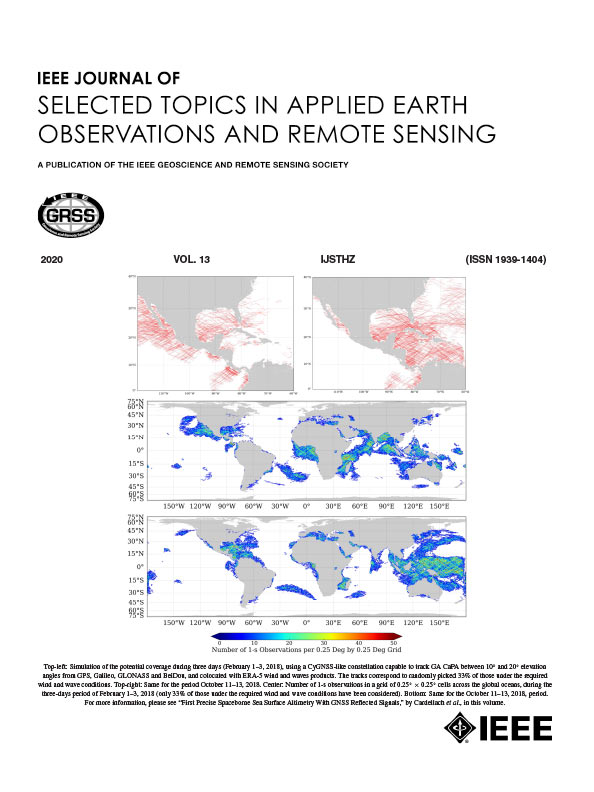Using Monoscopic Multispectral Earth Observation Images to Predict Terrain Features With Deep Neural Networks
IF 5.3
2区 地球科学
Q1 ENGINEERING, ELECTRICAL & ELECTRONIC
IEEE Journal of Selected Topics in Applied Earth Observations and Remote Sensing
Pub Date : 2025-08-25
DOI:10.1109/JSTARS.2025.3602630
引用次数: 0
Abstract
In the field of remote sensing and Earth observation, deep neural networks (DNNs) have established themselves as important tools for many different image analysis applications. Estimation of terrain features from optical satellite imagery is a rarely studied application for which DNNs are well suited because of their ability to extract and combine information at various scales. To predict terrain slopes in optical images, we propose an R2U-Net using global multispectral Sentinel-2 (S2) L2A images as input, and ALOS World 3-D DSM elevation data as target data. The R2U-Net takes advantage of a residual unit that benefits deep architecture training, and the recurrent residual convolutional layers provide better feature accumulation. Two models were experimented with; one model trained on only the optical RGB bands and one model trained on all S2 L2A bands. Evaluation of the multispectral- and RGB-trained models showed that the multispectral-trained model performs better than the RGB model, both during training and when evaluated on the test data. The multispectral model performs better overall than the RGB model in all the cases studied. Slope errors typically increase from low-gradient to high-gradient terrain, but not at the same rate as the slope steepness itself, while aspect errors decrease as the models struggle more to predict the slope aspect in low-gradient terrain. This highlights that, in this case, using more spectral bands when predicting terrain slopes helps improve the model predictions. The results have also been shown to depend on the incoming angle of the sunlight, which is mostly due to the topographic shadows that are being cast onto the terrain.基于单视角多光谱地球观测图像的深度神经网络地形特征预测
在遥感和地球观测领域,深度神经网络(dnn)已经成为许多不同图像分析应用的重要工具。从光学卫星图像中估计地形特征是一个很少被研究的应用,而深度神经网络因其在不同尺度上提取和组合信息的能力而非常适合。为了预测光学图像中的地形坡度,我们提出了一个R2U-Net,使用全球多光谱Sentinel-2 (S2) L2A图像作为输入,ALOS World 3-D DSM高程数据作为目标数据。R2U-Net利用残差单元进行深度架构训练,而递归残差卷积层提供了更好的特征积累。试验了两个模型;一个模型只在光学RGB波段上训练,一个模型在所有S2 L2A波段上训练。对多光谱和RGB训练模型的评估表明,无论是在训练过程中还是在测试数据上进行评估时,多光谱训练模型的性能都优于RGB模型。在所有研究的情况下,多光谱模型的总体性能优于RGB模型。坡度误差通常从低坡度到高坡度地形增加,但与坡度本身增加的速度不同,而坡向误差则随着模型在低坡度地形中更难以预测坡向而减小。这突出表明,在这种情况下,在预测地形坡度时使用更多的光谱波段有助于改进模型预测。结果也被证明取决于阳光的入射角度,这主要是由于地形阴影投射到地形上。
本文章由计算机程序翻译,如有差异,请以英文原文为准。
求助全文
约1分钟内获得全文
求助全文
来源期刊
CiteScore
9.30
自引率
10.90%
发文量
563
审稿时长
4.7 months
期刊介绍:
The IEEE Journal of Selected Topics in Applied Earth Observations and Remote Sensing addresses the growing field of applications in Earth observations and remote sensing, and also provides a venue for the rapidly expanding special issues that are being sponsored by the IEEE Geosciences and Remote Sensing Society. The journal draws upon the experience of the highly successful “IEEE Transactions on Geoscience and Remote Sensing” and provide a complementary medium for the wide range of topics in applied earth observations. The ‘Applications’ areas encompasses the societal benefit areas of the Global Earth Observations Systems of Systems (GEOSS) program. Through deliberations over two years, ministers from 50 countries agreed to identify nine areas where Earth observation could positively impact the quality of life and health of their respective countries. Some of these are areas not traditionally addressed in the IEEE context. These include biodiversity, health and climate. Yet it is the skill sets of IEEE members, in areas such as observations, communications, computers, signal processing, standards and ocean engineering, that form the technical underpinnings of GEOSS. Thus, the Journal attracts a broad range of interests that serves both present members in new ways and expands the IEEE visibility into new areas.

 求助内容:
求助内容: 应助结果提醒方式:
应助结果提醒方式:


